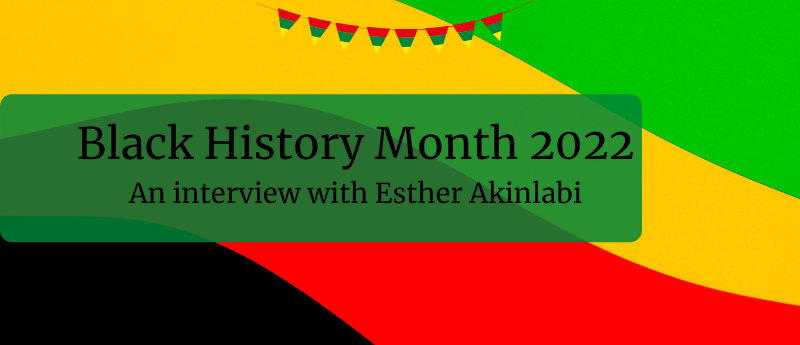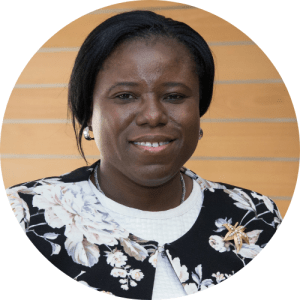Black History Month 2022: In conversation with Esther Akinlabi

As part of our interview series in celebration of Black History Month this year, we talk with Esther Akinlabi, Director of the Pan African University for Life and Earth Sciences Institute (PAULESI; Ibadan, Nigeria). Esther speaks to us about how her interests in 3D printing began and offers insights into how scientific communities can better promote Black History Month going forward.
Biography:

Esther Titilayo Akinlabi is currently serving as the Director of PAULESI. Prior to joining PAULESI, Professor Akinlabi spent a decade at the Department of Mechanical Engineering Science at the University of Johannesburg (UJ; South Africa) within the Faculty of Engineering and the Built Environment. During this period, she had the privilege of serving as the head of the Department of Mechanical Engineering Science and as the Vice Dean for the Teaching and Learning department of the faculty. Her research interest lies in the field of modern and advanced manufacturing processes. Professor Akinlabi was ranked within the top 1% of research output producers at the Faculty of Engineering and the Built Environments for many years up until her disengagement from service at the University of Johannesburg. She also ranked in first position among the top 500 researchers globally in the field of lasers, titanium alloys and powder feeders from 2017–2019.
She is a rated National Research Foundation (Pretoria, South Africa) researcher and has demonstrated excellence in all fields of endeavors. Her leadership, mentorship and research experience are enviable as she guides her team of postgraduate students through their research journeys. She has supervised the completion of 30 PhD and 42 Master’s students. She is the recipient of several local and international research grant awards and has also received many research awards. Professor Akinlabi is an alumnus of the prestigious South African Young Academy of Science (Pretoria, South Africa) and was recently appointed as a fellow of the Africa Academy of Science (Nairobi, Kenya). She is also a fellow of the Nigerian Academy of Science (Lagos, Nigeria) and a registered member of a number of professional bodies. She has filed two patents, edited four books, published seven books and authored or co-authored over 600 peer-reviewed publications.
What sparked your interest in 3D printing and what has been the path of your career since then?
Upon the completion of my PhD in the field of friction stir welding (FSW) in mechanical engineering at the Nelson Mandela Metropolitan University (Gqeberha, South Africa) in 2010, I was hired as a lecturer at UJ. UJ, at that time, did not have an FSW machine and I had to travel to Port Elizabeth a number of times to get access to the FSW machine to continue my research. Further along the line, my husband, Dr Stephen Akinlabi, was busy with his PhD in the field of laser forming at the Council for Scientific and Industrial Research (CSIR; Pretoria, South Africa). I used to travel with him to the laser facility at the CSIR and it was during one of my trips that I met Professor Sisa Pityana, who introduced me to various machines that they had in their facility and later became my mentor in the field of additive manufacturing. The machines he showed me included the additive manufacturing systems utilized for 3D printing and I became fascinated with the way the machines worked. After producing some samples, the rest is history regarding my journey of over a decade of research and development in 3D printing.
How diverse is the field of 3D printing?
I consider the field of 3D printing as very diverse because it encompasses many aspects of science, engineering and creative arts and design. Researchers in the following fields work hand-in-hand with 3D printing: materials scientists, physicists, engineers of all different fields, artists and designers.
What advice would you give to young Black scientists trying to get into the field of 3D printing?
My advice to young scientists trying to get into the field of 3D printing is that it has a lot of opportunities to explore. For example, while scientists are still working on 3D printing, 4D printing has already evolved.
I wouldn’t say I have any specific resources, but the field of 3D is very popular. There are so many materials and resources in the open literature. I would encourage young scientists to read widely and be knowledgeable in 3D printing, 4D printing and functionally graded materials.
How can organizations promote and encourage diversity in recruitment and retention?
Organizations have to be intentional in their strategies to promote and encourage diversity in recruitment and retention. I am an advocate of merit and excellence; the best candidate should be recruited for positions, irrespective of their backgrounds.
Do you have any thoughts on how we might better promote Black History Month amongst the scientific community in the future?
I believe that a lot more needs to be done in role modeling similar to how you have contacted me in this case. I am always open and try my best to share my story on various platforms when opportunities present themselves; I hail from a village called Kabba in Kogi State in Nigeria. I have had some role models in my life that have impacted me positively and influenced who I am today.
